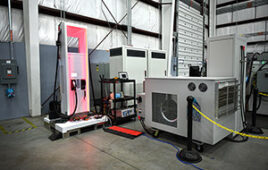‘Wireless’ humans could form backbone of new mobile networks
Members of the public could form the backbone of powerful new mobile internet networks by carrying wearable sensors.
According to researchers from Queen’s University Belfast, the novel sensors could create new ultra high bandwidth mobile internet infrastructures and reduce the density of mobile phone base stations.
The engineers from Queen’s renowned Institute of Electronics, Communications and Information Technology (ECIT), are working on a new project based on the rapidly developing science of body centric communications.
Social benefits from the work could include vast improvements in mobile gaming and remote healthcare, along with new precision monitoring of athletes and real-time tactical training in team sports.
The researchers at ECIT are investigating how small sensors carried by members of the public, in items such as next generation smartphones, could communicate with each other to create potentially vast body-to-body networks (BBNs).
The new sensors would interact to transmit data, providing ‘anytime, anywhere’ mobile network connectivity.
Dr Simon Cotton, from ECIT’s wireless communications research group said: “In the past few years a significant amount of research has been undertaken into antennas and systems designed to share information across the surface of the human body. Until now, however, little work has been done to address the next major challenge which is one of the last frontiers in wireless communication ? how that information can be transferred efficiently to an off-body location.
“The availability of body-to-body networks could bring great social benefits, including significant healthcare improvements through the use of bodyworn sensors for the widespread, routine monitoring and treatment of illness away from medical centres. This could greatly reduce the current strain on health budgets and help make the Government’s vision of healthcare at home for the elderly a reality.
“If the idea takes off, BBNs could also lead to a reduction in the number of base stations needed to service mobile phone users, particularly in areas of high population density. This could help to alleviate public perceptions of adverse health associated with current networks and be more environmentally friendly due to the much lower power levels required for operation.”
Dr Cotton has been awarded a prestigious joint five-year Research Fellowship by the Royal Academy of Engineering and the Engineering and Physical Research Council (EPSRC) to examine how the new technology can be harnessed to become part of everyday life.
He added: “Our work at Queen’s involves collaborating with national and international academic, industrial and institutional experts to develop a range of models for wireless channels required for body centric communications. These will provide a basis for the development of the antennas, wireless devices and networking standards required to make BBNs a reality.
“Success in this field will not only bring major social benefits it could also bring significant commercial rewards for those involved. Even though the market for wearable wireless sensors is still in its infancy, it is expected to grow to more than 400 million devices annually by 2014.”
Further information on the work of ECIT’s Wireless Communications Research Group can be found online at www.ee.qub.ac.uk/wireless/
Media inquiries to Lisa McElroy, Communications Office. Tel: 00 44 (0)28 90 97 3091 or email [email protected]
Notes to editors
Dr Cotton is available for interview. Please telephone Lisa McElroy to arrange on 00 44 (0)28 90 97 3091
Along with ECIT’s Professor William Scanlon ? who holds the Queen’s Chair in Wireless Communications – he has just been awarded one of the top international awards in his field by IEEE – the world’s largest professional association dedicated to advancing technological innovation and excellence for the benefit of humanity. The duo received the H A Wheeler Prize Paper Award ? for a study on a wireless body centric radio system that could be used by the emergency services.
Dr Cotton and his team have already worked with clients such as the UK Ministry of Defence to develop futuristic communications systems incorporating arrays of highly specialised body-worn antennas that could help protect frontline troops.
Accompanying illustration – BBNs just for fun
BBNs have many potential applications from community healthcare and mobile gaming to live streaming of music and sports events. An illustration is available explaining the following example:
You are at a music festival and your friend is at the bar queuing for drinks. His favourite artist has just appeared on-stage for an impromptu performance with some other celebrities.
You get out your smartphone and using BBN, you “stream” the jam session live to your friend in the drinks queue. The information stream consists of short packets of video data that are passed person to person and routed to your friend’s smartphone.
The other “bodies” at the concert all contribute a little of their energy and bandwidth to achieve this but this does not require their explicit knowledge – the smartphone software looks after it.
The alternative, of course, is to store the video on your phone, upload it to the Internet, text your friend who would then have to download it. Doing it this way however means you lose the spontaneity and fun! It also requires more power (long range links to the cellular network take more energy) and it would also use a lot of the cell network bandwidth – as the coverage is greater, the bandwidth cannot be re-used until your video is uploaded.
ECIT
Part of The School of Electronics, Electrical Engineering and Computer Science at Queen’s University Belfast, ECIT is housed in a specially designed 4,000m2 building, located off-campus, at the Northern Ireland Science Park in Belfast’s Titanic Quarter. The Institute has four research groups covering areas such as broadband wireless communications, electronic data security, image and speech processing, telecommunications software and antenna design for mobile communications. The Institute currently employs 140 people.
Wireless Communications Research Group is part of ECIT’s Digital Communications cluster. Its work is focused around physical layer, link layer and, more recently, cross-layer solutions for challenging applications that demand efficiency, performance and reliability.
Current projects are clustered around antennas and radiowave propagation for personal and vehicular communications, wireless networking protocol design and modelling, and low-power, low-cost radios. Applications range from RFID to wireless body area networks to wireless networked control to telemedicine, spanning UHF to mm-wave frequencies.
EPSRC
The Engineering and Physical Sciences Research Council (EPSRC) is the UK’s main agency for funding research in engineering and the physical sciences. The EPSRC invests more than £850 million a year in research and postgraduate training to help the nation handle the next generation of technological change.




